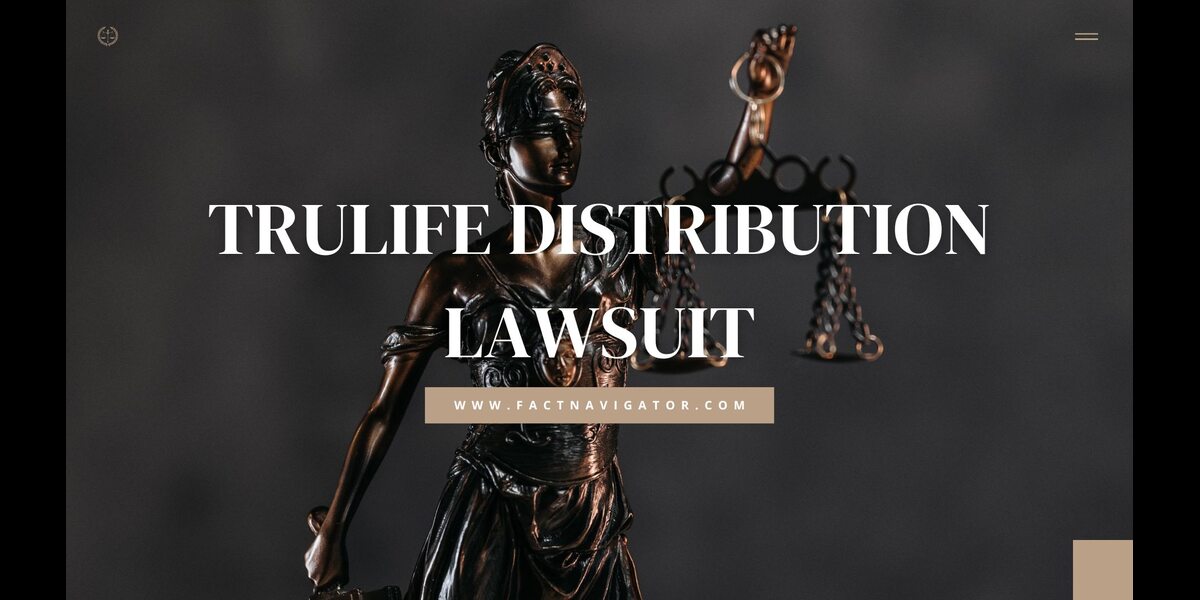Trulife Distribution Lawsuit: Allegations & Impacts

The Trulife Distribution lawsuit is shaking the foundations of the health and wellness industry. More than just a battle between two companies, this case delves into allegations of false statements, stolen success stories, and the very definition of fair competition. The lawsuit’s outcome could have far-reaching consequences, reshaping how businesses market themselves and protect their hard-earned reputations.
1. Understanding the Core Conflict
At the heart of the Trulife Distribution lawsuit lies a set of serious allegations leveled by NPI against its competitor. To grasp the lawsuit’s significance, it’s crucial to dissect each of NPI’s primary claims against Trulife Distribution.
NPI’s Allegations – What Are the Key Claims?
- False and Misleading Statements: NPI asserts that Trulife Distribution engaged in a pattern of making untrue or deceptive statements designed to harm NPI’s relationships with current clients and potential business partners. These statements allegedly misrepresented facts about NPI, Trulife, or the capabilities of both companies, casting NPI in a negative light.
- Misappropriation of Case Studies: A cornerstone of NPI’s complaint is the accusation that Trulife Distribution took NPI’s internal case studies and presented them as their own achievements. Case studies are vital in the health and wellness industry, as they showcase a company’s success in helping clients achieve their goals. NPI alleges that by taking their success stories, Trulife essentially stole NPI’s hard-earned reputation.
- Unfair Competition Tactics: NPI’s lawsuit paints a picture of Trulife Distribution engaging in a broader pattern of unfair business competition. This includes the previously discussed elements and potentially other tactics like the use of an email address designed to mislead NPI’s clients into thinking communication was from NPI itself.
Trulife Distribution’s Defense
It’s vital to remember that a lawsuit presents one side of a dispute. To ensure a balanced understanding, it’s necessary to consider Trulife Distribution’s defense (to the extent it’s publicly available). Their counter arguments might include:
- Denial of Misleading Statements: Trulife might forcefully deny making false claims or deliberately misrepresenting NPI. They could provide evidence supporting their statements’ truthfulness.
- Dispute Over Case Study Ownership: Trulife might argue that the case studies were not exclusively NPI’s property, or that they were significantly modified to reflect Trulife’s own strategies.
- Justification of Competitive Actions: Trulife’s defense could center on asserting that their actions fall within the bounds of healthy competition in the industry and do not violate laws against unfair business practices.
2. The Deeper Context: Family Ties and Industry Rivalry
The Trulife Distribution lawsuit isn’t simply a clash of businesses; it’s a dispute with a highly personal dimension. The founders or principals of both NPI and Trulife Distribution are related. This family connection throws a unique and complex wrinkle into an already contentious legal battle.
When Business Gets Personal
- Emotional Entanglement: Family dynamics inevitably add an emotional layer to business conflicts. Issues like trust, perceived betrayal, and longstanding resentments can fuel legal disputes far more intensely than disagreements between unrelated parties.
- Reputational Damage: Lawsuits between family members can have far-reaching consequences for the reputations of everyone involved. The airing of grievances in a public forum like a courtroom can tarnish not only the companies’ images but also the standing of individuals and the family name itself.
- Difficulty in Resolution: The emotional entanglement of family-linked lawsuits can make reaching a settlement or compromise extremely difficult. Pride, hurt feelings, and the desire to “win” at the expense of one’s relative can overshadow rational decision-making.
A History of Conflict?
Understanding the Trulife Distribution lawsuit’s full context may require investigating whether there’s a history of legal battles or other significant disputes between the involved parties.
- Prior Disputes: If previous legal actions exist, they signal a longstanding pattern of conflict that makes the current lawsuit more likely a bitter culmination rather than an isolated incident.
- Pattern of Behavior: Examining past disputes might reveal patterns in accusations, tactics, or outcomes. This could provide clues about both sides’ approaches in the current lawsuit.
- Implications for the Lawsuit: If a history of conflict exists, judges or juries might view the Trulife Distribution lawsuit through a particular lens. Prior actions could suggest a motive of revenge or support claims of a recurring pattern of unfair competition by Trulife.
3. What’s at Stake in the Trulife Distribution Lawsuit
The Trulife Distribution lawsuit extends far beyond its direct impact on NPI and Trulife. The case’s outcome has wide-ranging implications for the health and wellness industry and beyond.
Beyond Individual Companies: Industry Impacts
- Precedent-setting for Fair Competition Practices: The way the Trulife Distribution lawsuit is resolved could set crucial precedents for what constitutes fair and unfair competition in the health and wellness sector. The court’s decisions on what is considered misleading or deceptive could shape future business practices for years to come.
- Potential changes in how success stories are used in marketing: Case studies are powerful tools in the industry. The Trulife Distribution lawsuit highlights the potential for misuse of case studies and could lead to stricter guidelines or industry self-regulation regarding their ownership and presentation.
Financial Stakes
- Potential damages sought by NPI: NPI is likely seeking significant financial compensation for the damages they allege Trulife’s actions caused. The final amount, if awarded, could be substantial and impact Trulife’s operations.
- Trulife’s potential losses (reputation, business deals): Beyond direct financial losses, Trulife Distribution faces severe reputational damage due to the lawsuit’s allegations. This damage could lead to lost clients, difficulty securing new business partnerships, and a general erosion of their standing within the industry.
Reputation and Trust in the Wellness Sector
- How the lawsuit could impact consumer confidence: High-profile lawsuits like the Trulife Distribution lawsuit can shake consumer confidence in the wellness industry as a whole. Consumers may become more skeptical of marketing claims, question the ethics of companies, and hesitate before making purchasing decisions. This skepticism could slow the growth of legitimate businesses in the sector.
Also Read: OpenHousePerth.Net Lawyer: Your Trusted Legal Partner
4. Expert Analysis: What Legal Professionals Are Saying
The Trulife Distribution lawsuit raises complex legal questions that are best illuminated by the perspectives of experts in the field. Understanding the key legal concepts and potential outcomes adds depth to our understanding of the case.
Key Legal Concepts at Play
- Deceptive Trade Practices: This area of law focuses on protecting businesses and consumers from untruthful or misleading statements and practices designed to gain an unfair competitive advantage. NPI’s lawsuit heavily relies on claims that Trulife engaged in deceptive practices.
- Unfair Competition: A broader legal concept, unfair competition encompasses actions that harm competitors through dishonest or unethical means. This could include misappropriating trade secrets, poaching clients through improper tactics, or creating harmful confusion in the marketplace.
- Misappropriation of Trade Secrets: Trade secrets can include valuable internal information like client lists, formulas, or proprietary marketing strategies. NPI’s allegation about the misuse of case studies could potentially fall under this category if it can be proven that these case studies contained confidential information that Trulife wasn’t authorized to use.
Potential Outcomes and Precedents
- Similar Cases and Their Resolutions: Examining past lawsuits involving deceptive trade practices, unfair competition, or misappropriation of trade secrets can offer clues as to how the Trulife Distribution lawsuit might play out. Analyzing the outcomes of those cases can give us insights into potential penalties or injunctions.
- Speculation on How the Trulife Case Might Unfold: While it’s essential to emphasize the uncertainty of ongoing cases, legal experts might offer informed speculation on the possible trajectories of the Trulife Distribution lawsuit. They might discuss likely legal strategies, factors that could influence the judge or jury, and the potential for settlement versus a lengthy courtroom battle.
5. What Does the Future Hold?
The outcome of the Trulife Distribution lawsuit remains uncertain, but several scenarios could drastically shape the futures of the companies involved and ripple throughout the industry.
Possible Resolutions
- Out-of-court Settlement: Lawsuits are often resolved before reaching a courtroom verdict. NPI and Trulife could reach a confidential settlement agreement involving financial compensation, changes to business practices, and potentially a non-disclosure agreement to prevent public discussion of the terms.
- Lengthy Court Battle and its Implications: If the Trulife Distribution lawsuit goes to trial, both sides could face a prolonged and expensive legal process. The trial would likely reveal more details, potentially further damaging reputations and disrupting both companies’ operations.
Lasting Impact on NPI and Trulife
Regardless of the specific outcome, the Trulife Distribution lawsuit is likely to leave a permanent mark on both NPI and Trulife Distribution.
- NPI: Even if NPI wins significant financial compensation, the lawsuit might have lingering effects on client relationships and industry trust. However, a successful outcome could reaffirm their reputation and deter future unfair practices from competitors.
- Trulife Distribution: If the court finds in favor of NPI, Trulife may face significant financial losses and irreparable reputational damage. This could severely impede their ability to compete in the market.
How the Industry Might Adapt
The Trulife Distribution lawsuit serves as a cautionary tale for the health and wellness industry. It may lead to:
- Stricter Internal Controls: Companies might implement more rigorous safeguards on confidential information and set clearer policies about what can be shared with former employees who start competing businesses.
- Re-evaluation of Marketing Practices: Companies could become more cautious when using case studies and client success stories, prioritizing transparency and obtaining explicit consent.
- Increased Scrutiny: The industry as a whole may face heightened scrutiny from watchdogs or consumer protection agencies, prompting a proactive effort towards greater ethical standards.
The Bottom Line
The Trulife Distribution lawsuit is far more than a quarrel between two businesses. It’s a case that sends tremors through the health and wellness industry, forcing companies to re-examine their competitive practices and sparking a deeper conversation about ethics in marketing. Here are the crucial takeaways:
- High Stakes for Businesses: The lawsuit underscores the severe consequences of engaging in deceptive trade practices or unfair competition. Companies risk not just financial losses but devastating damage to their long-term reputation and viability.
- Precedent Potential The outcome of the Trulife Distribution lawsuit could shape how courts define fair competition in the industry. It may lead to stricter definitions of what constitutes the misuse of case studies or misappropriation of proprietary information.
- Consumer Trust is Key: Lawsuits like this highlight the importance of consumer trust as a foundational element of the wellness sector. If companies can’t be trusted to present themselves and their achievements honestly, consumers may become hesitant to engage with any business in the industry.
- The Need for Ongoing Vigilance: The Trulife Distribution lawsuit serves as a stark reminder that businesses can’t afford to be complacent when it comes to ethical practices. Companies must proactively monitor their own actions and those of competitors to uphold standards and foster a marketplace built on fair play.

